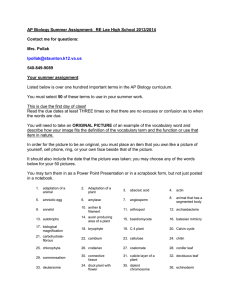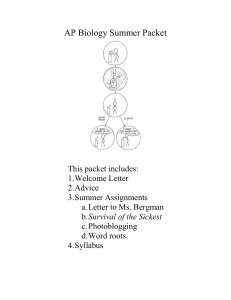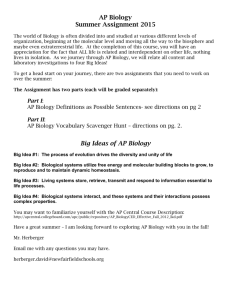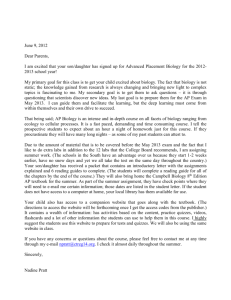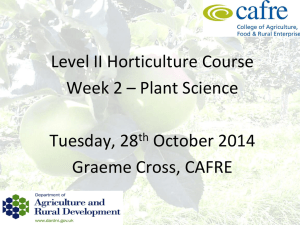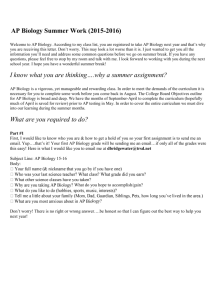Dear AP Biology Student, - School Without Walls Biology
advertisement
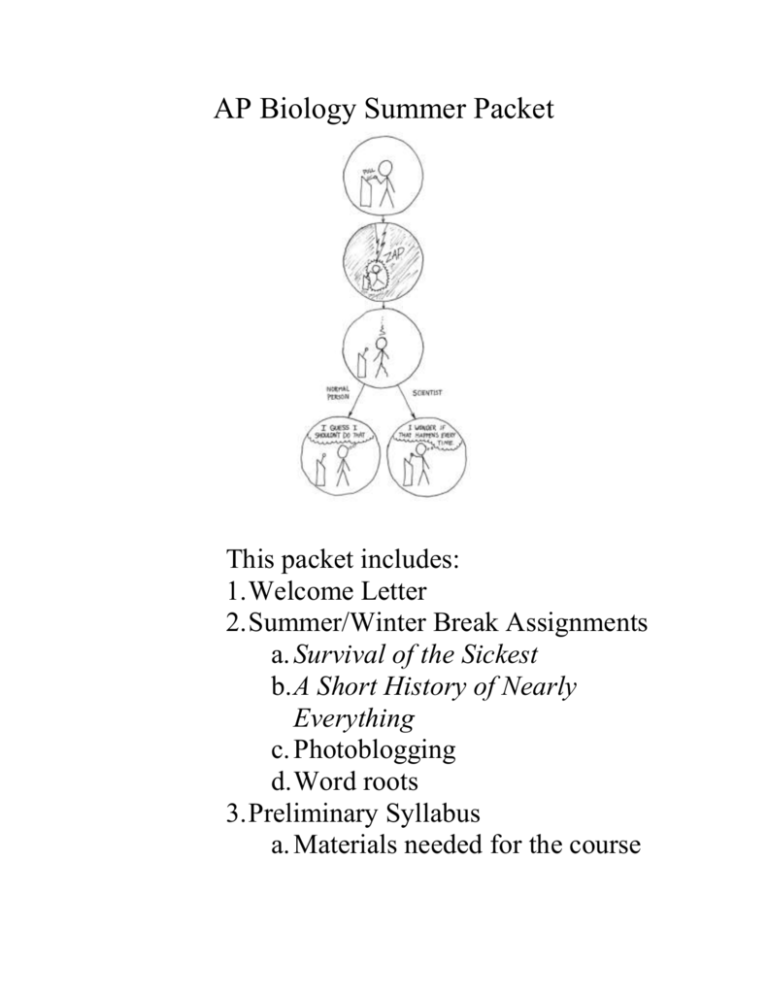
AP Biology Summer Packet This packet includes: 1. Welcome Letter 2. Summer/Winter Break Assignments a. Survival of the Sickest b. A Short History of Nearly Everything c. Photoblogging d. Word roots 3. Preliminary Syllabus a. Materials needed for the course Dear AP Biology Student, Although it is the end of the school year, and not the beginning, I would like to take a moment to welcome you to next year’s AP Biology class, and help you prepare for this upcoming challenge. AP Biology involves a lot of hard work, but it can be incredibly rewarding. We have a lot of fascinating labs planned, and I am looking forward to an exciting year with all of you. Of course, there is a catch. Somewhere between hanging out with friends, lounging on beaches, and just plain sleeping in, I have several assignments for you. While these may not be entirely fun (but I hope they will be!), they will help you and benefit your overall success in this course. 1. Summer reading: You will be reading ONE of the following two texts this summer. Both are written at a college-level, but are engaging and interestingly written. Whichever one you do not pick you will be reading over winter break! a. SELECT ONE! Moalem, Sharon. Survival of the Sickest. New York: HarperCollins, 2007. o Entire book (267 pages). Bryson, Bill. A Short History of Nearly Everything. New York: Random House, Inc., 2003. o Pages 154 (From “Life Itself”) to 298 (through “Goodbye”). o I can provide you with a PDF of this book. Your assignment for each of these books is attached. 2. Summer photoblogging/sketching assignment. For this assignment, you will find and photograph or sketch the following vocabulary words. This will introduce you not only to the language of biology, but also emphasize that biology is something that’s DONE not just memorized. The list of vocab words and requirements for the photoblog are attached. Reading and photoblogging assignment: Due Friday, August 28th, 2009 by 3:30pm. 3. Word roots This assignment does not strictly need to be done over the summer, but will help you tremendously, particularly with the photoblogging assignment. AP Biology can sound like a foreign language sometimes. Learning the root words that make up this terminology can make the rest of the course significantly easier. Beginning on the second week of class, and continuing at short intervals thereafter, you will have a series of seven root word quizzes. As you are receiving this list now, I hope you will take the opportunity to avoid the stress of trying to learn all of these during the busy first weeks of the school year. Feel free to contact me when necessary. Our class webpage can be accessed from biowithoutwalls.com, and you can email me at biowithoutwalls@gmail.com. Feel free contact me over the summer either via email or via comment to the website. I will try to respond within a week, but generally sooner. Have a great summer! Ms. Bergman Summer Reading Assignment: Select ONE of the following. The other will be done over winter break! Survival of the Sickest Introduction 1. What is the “big” question the book will attempt to answer? Chapter I 2. The author points out many ways in which iron impacts life. Identify/describe at least five. 3. In the context of this chapter, explain the author’s reference to Bruce Lee and to the barber pole. Chapter II 4. Distinguish between each of the three types of diabetes. 5. What did the ice cores of 1989 reveal about the Younger Dryas? 6. Describe the body’s “arsenal of natural defenses” against cold. 7. Describe the connection between Rana sylvatica and diabetes. 8. In Chapters I and II several inherited disorders were discussed. Create and complete a chart with the following information: Disease/Disorder, Symptoms, Evolutionary Advantage. Chapter III 9. Why do we need Vitamin D? Cholesterol? Folic acid? 10. Briefly describe the connection between the two concepts: a. tanning beds; birth defects b. sunglasses; sunburn c. hypertension; slave trade d. Asian flush; drinking water e. skull shape; climate f. body hair; malaria 11. What’s so fishy about the Inuits’ skin color? 12. Explain the good and the bad of ApoE4. Chapter IV 13. Explain the role of G6PO. 14. Briefly describe the connection between the two concepts: a. European clover; Australian sheep breeding crisis of the 1940s b. Capsaisin; birds and mammals c. Malaria; air conditioning d. Favism; fava beans 15. Explain the following statement found on page 87: “Life is such a compromise.” Chapter V: “Of Microbes and Men” 16. Complete Parasite Chart (Go to end of assignment.) 17. Identify 3 ways in which microbes/parasites move from host to host. 18. For each pathway listed in question #2, explain the relationship of the mode of transmission to the virulence of the invader. 19. What is our advantage in the survive-and -produce race? Chapter VI: “Jump Into the Gene Pool” 20. Briefly discuss the following terms/scientists: a) Jenner b) vaccine c) antibodies d) B-cells e) “junk DNA” f) Lamarck g) McClintlock h) retroviruses 21. What is the Weissman barrier? 22. Make connections between the following terms: a. transposons; viruses; evolution b. sunspots; flu epidemics 23. Humans have about 25,000 genes and more than a million different antibodies. How is this possible? 24. What is a persisting virus? Chapter VII: “Methyl Madness” 25. Make connections between the following terms: a) vitamin supplement; agouti mice b) snakes; long-tailed lizards c) Barker Hypothesis; fathers who smoke d) Smoking grandmothers; asthmatic children e) Betel nut chewing; cancer 26. Epigenesis may be partially responsible for the childhood epidemic of obesity. Explain. 27. “Good times mean more boys. Tough times mean more girls.” Explain. Chapter VIII: “That’s Life: Why You and Your iPod Must Die” 28. Make connections between the following terms: a) Progeria; lamina A b) Hayflick limit; telomeres c) Caner cells; stem cells d) Size; life expectancy e) Risky child birth; big brains and bipedalism 29. Explain the author’s iPod and aging analogy. 30. Identify the 5 lines of cancer defense. 31. What are the two accomplishments of biogenic obsolescence? 32. Compare and contrast the Savanna and aquatic ape hypotheses. Conclusion 33. The author hopes that you will come away from this book with an appreciation of three things: a) Life is in a constant state of creation b) Nothing in our world exists in isolation c) Our relationship with disease is often much more complex than we may have previously realized. On a personal note, what would you add to his list? 34. “Nothing in biology makes sense except in the light of evolution.” How does the book, Survival of the Sickest, support this quote by Theodosius Dobzhansky, a noted evolutionary biologist? A Short History of Nearly Everything For each chapter you need to EITHER keep a typed reflective journal of your reaction to the text OR blog your reaction online on your AP bio blog. Please break down your summaries/reactions accordingly: One summary/reaction per chapter. (15 total). (1 point each) Your reactions should be written in standard English, though you may use personal pronouns (I, we, etc.). (1 point each) o No text message short hands such as LOL, etc. o Take the time to correct typos, grammar mistakes, etc. Your summaries/reactions must contain at least 2 paragraphs o 1st paragraph = summary of the chapter (2 points each) o 2nd paragraph = reflection/thoughts on the chapter (2 points each) Some prompts to help get you started are below. You are not limited to these nor need to include all of these: o What is your immediate reaction/thought after reading this chapter? o How does this relate to your personal life? o Do you agree or disagree with the author’s ideas? o Did you find the chapter interesting and why? o Did the chapter raise any questions for you? What are they? o If you are blogging, feel free to raise questions to your classmates. Don’t ask a single individual but something along the lines of …”How do you feel about the statement on p.#...” o If you are journaling, please include questions you had/topics you would like to discuss. Biological Scavenger Hunt Your assignment is to catalogue 40 of the biological items on the following list during the summer. Your grade will be the point value of the items you collect. Although this assignment is a 120-point assignment, you would be better off collecting MORE than 120 points worth of things to allow for some things not meeting requirements. To prove that you’ve seen the items, you must submit either; A photograph of the object with a picture of you or your thumb by it, or A signed hand-drawn image of the object in its found location, or A newspaper or magazine article that has that object as its primary subject, or An internet article/image of the organism (limited to 5 submissions maximum). Every organism submitted must be labeled with the properly-formatted scientific name and the location of the organism. For example, a dog in the Logan Building’s yard would be labeled as Canis familiaris; 215 G Street NE, Washington, DC. Newspaper and magazine articles must include a correct MLA citation for the article and the article must have been written during the summer (June to August 2009). CAUTIONS: Never touch plants or animals with exposed fingers. Avoid touching the organisms but if you must, use gloves and/or forceps. Remember, we don't want to deplete the environment. Don’t kill organisms. Organisms should be photographed or drawn in their native habitat. An example of this blog (though without locations and scientific names) can be found here: http://apbio12008.blogspot.com/. You have several options for turning in this assignment. You may: 1. Submit it as a packet of drawings, photos, articles, etc., with a TABLE OF CONTENTS indicating which term each item fulfills. –OR2. Submit it as a photoblog here: http://swwapbio2009.blogspot.com/. To do this, you simply email: biowithoutwalls.swwapbio2009@blogger.com. Attach your pictures as .jpg files. Include what you want published in the text of your email. INCLUDE YOUR FIRST NAME IN THE SUBJECT LINE! I will screen each post and publish them accordingly. Because there is a size limit on photos, please send these with a MAXIMUM of 10 photos per post. If your post is bounced, you need to reduce the number of pictures/post. Specimen List: Below are the items you are to collect. An individual organism can only be used once. Humans are acceptable for one category only. You may use internet-based images for no more than 5 of these items. Grade breakdown: 1 point for each specimen, 1 point for each scientific name, 1 point for location = 120 points 1.adaptation of an animal 2. adaptation of a plant 3. abscisic acid 4. actin 5. amniotic egg 6. amylase 7. angiosperm 8. animal that has a segmented body 9. annelid 10. anther & filament of stamen 11. arthropod 12. archaebacteria 13. autotroph 14. auxin producing area of a plant 15. basidiomycete 16. Batesian mimicry 17. biological magnification 18. bryophyte 19. C4 plant 20. Calvin cycle 21. carbohydrate - fibrous 22. cambium 23. cellulose 24. chitin 25. chlorophyta 26. cnidarian 27. coelomate 28. conifer leaf 29. commensalism 30. connective tissue 31. cuticle layer of a plant 32. deciduous leaf 33. deuterostome 34. dicot plant with flower & leaf 35. diploid chromosome number 36. echinoderm 37. ectotherm 38. endosperm 39. endotherm 40. enzyme 41. epithelial tissue 42. ethylene 43. eubacteria 44. eukaryote 45. exoskeleton 46. fermentation 47. flower ovary 48. frond 49. fruit - dry with seed 50. fruit - fleshy with seed 51. gametophyte 52. gastropod 53. genetically modified organism 54. gibberellins 55. glycogen 56. gymnosperm cone 57. haploid chromosome number 58. heartwood 59. hermaphrodite 60. insect 61. K-strategist 62. keratin 63. leaf - gymnosperm 64. lepidoptera 65. lichen 66. lignin 67. lipid used for energy storage 68. littoral zone organism 69. long-day plant 70. meristem 71. modified leaf of a plant 72. modified root of a plant 73. modified stem of a plant 74. monocot plant with flower & leaf 75. muscle fiber - striated 76. mutualism 77. mycelium 78. mycorrhizae 79. myosin 80. nematode 81. niche 82. nymph stage of an insect 83. parasite 84. parenchyma cells 85. phloem 86. pine cone - female 87. platyhelminthes 88. pollen 89. pollinator 90. porifera 91. prokaryote 92. protein - fibrous 93. protein - globular 94. protostome 95. pteridophyte 96. r-strategist 97. radial symmetry 98. rhizome 99. scale from animal with two-chambered heart 100. spore 101. sporophyte 102. stem - herbaceous 103. stem - woody 104. stigma & style of carpel 105. tendril of a plant 106. thorn of a plant 107. unicellular organism 108. vascular plant tissue 109. xerophyte 110. xylem WORD ROOTS FOR QUIZZES The quizzes will ask you to either define the word root or to give the word root for the definition. You will be given word roots or definitions and asked to provide the word root. Subsequent quizzes may have word roots that appeared on previous quizzes. To practice for the quiz, I recommend flashcards or playing “memory.” QUIZ 1 A-, anabac-aceus; -aceous acr-; acroadadeno-al alballoamph-; ambananaandroanteanteroanthoantiapaquarchaeoarthro-ase -ate -ation autobeneBibio-; bi-blast brachibranchibronchcarbcardicarncarpcarpalcaud- no; lacking; none away from; out from to; toward of or pertaining to extreme; peak to; toward gland having character of white other both not; without up, away masculine; man before; ahead of time front flower against to; toward water primitive; ancient joint referring to enzyme activity used in forming verbs from nouns used in forming nouns from verbs self well; good two; twice; double life; living sprout; germ having arms having fins windpipe coal; carbon heart meat fruit wrist tail QUIZ 2 cellcenticentrcephalchemchlorchondrchrom-; -chrome -cide circumcoCoccCoelcollComconcontraCorpcotylcountercrypt-cule; -culus cutiCyan -cycle; cyciCystcyt-; -cyte DecaDecidemidendrDentDermdidiaDigit disdormDors- storeroom; chamber hundredth center head referring to chemistry green cartilage color killing around; about with; together seed hollow glue with; together with; together against body cup against hidden; covered added to nouns to form diminutive skin blue ring; circle bladder; pouch cell; receptacle ten tenth half tree tooth skin two; double through; across finger; tow apart; out sleep back du-; duo -duct dynamdysecechinecoQUIZ 3 ecten-en encephalend-; ententer-eous epierythroeuextraex-fer fibr-fid; fis-flect; -flex florfoligastro-gen; -gine -gene; gene-gest glob-gon -gony -graphy; -graph gravgymnogyngyrhaem-; hemhepatherbheterohexQUIZ 4 histholohomohydr- two lead power ill; bad out of; outside spiny; prickly house outside; without in; into made of brain within; in intestines nature of; like on; above red well; good, true beyond; outside of out of bear; carry; produce fiber; thread divided into; split bend flower leaf stomach producer; former origin carry; produce ball; round angle; corner offspring; generation; coming into being writing; record heavy naked female ring; circle; spiral blood liver grass different; other six tissue entire; whole same; alike water hypohyperhypno-ic ichthyiminin-ine infrointerintra-ion -ism iso-itis kilolat-less leuclignlinliplith-; -lite -logy -lysis; -lyte; -lyst macrmalmammmargmedmegmela-; melanmesmet-; meta-meter; -metry QUIZ 5 micromillimismonomortmov-; -mot morphmultimoll- beneath; under; less above; beyond; over sleep added to nouns to form adjectives fish not to; toward; into not of or pertaining to below, beneath between within; inside go; come a state or condition equal; same inflammation; disease thousand side; flank without white; bright; light wood line fat stone; petrifying study dissolve; decompose large bad; evil breast border; edge middle great; million black; dark middle; half; intermediate between; along; after way of measuring, instrument for measuring small thousandth wrong; incorrect one; single death move shape; form many soft mycmyoneonephroneur-; nervnoct-; nox-nomy; -nome nonnotnucoboculoct-oid olfomniooopthal-osis oste-ous ovoxypaleopalmpanparpath-; -pathy -ped pentQUIZ 6 perpermeaphagphenophilphon-;-phone -phore photo-phyte; phyt-pod polyporportpostpreproprotopseud- fungal muscle new; recent kidney nerve; tendon night distribute; arrange; law not back center against eye eight like in form or shape smell all egg eye state or condition of bone full of; abounding in egg sharp; acid; oxygen old; ancient broad; flat all beside; near; equal; bring forth disease; suffering foot five through pass; go eat show living; fond of sound bearer light plant foot many; several opening carry after; behind before; ahead of time forward; favoring first; primary false; deceptive pulmoquadrquinradirerenrhizrubrsaccharosaprsclersciscope semiQUIZ 7 septsexsolvspermspher-spire spore statstom-; -stome stratstereostrictstylsubsupersym-; syn-taxis teletetrthall therm-tom toxicotranstritrophultraurventrvit-; vivxanthinzo-; -zoa zyg- lung four; four-fold five ray; spoke of a wheel; energy in rays again; back kidney root red sugar rotten hard know look; observe half; partly partition; seven six loosen; free seed ball breathe seed standing; placed mouth layer solid; three dimensions drawn tight pillar under; below over; above; on top together movement far off; at a distance four young shoot heat cut; slice poison across three one who feeds; well fed beyond urine belly life yellow animal yolk
